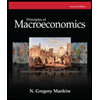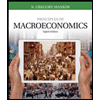
(a)
Determine the values of national saving, capital inflows, domestic investment, and the real interest rate.
(a)
Explanation of Solution
Since the savings is the sum total of national savings and the capital inflow, the saving–investment equality can be represented as follows:
Rearrange the equation to get the value of the real interest rate (r) as follows:
Thus, the real interest rate is 0.05 or 5%.
Substitute the value of ‘r’ in the given functional form of domestic supply of saving:
Thus, the domestic saving is 1,600.
Substitute the value of ‘r’ in the given functional form of investment:
Thus, the investment is 1,800.
Substitute the value of ‘r’ in the given functional form of capital inflow:
Thus, the capital inflow is 200.
(b)
Determine the values of national saving, capital inflows, domestic investment, and the real interest rate.
(b)
Explanation of Solution
If the desired national savings declined by 120, then the new functional form of domestic savings can be represented as follows:
Since the savings is the sum total of national savings and the capital inflow, the new saving–investment equality can be represented as follows:
Rearrange the equation to get the value of the real interest rate (r):
Thus, the real interest rate is 0.06 or 6%. This means that the real interest rate increases from 5% to 6%
Substitute the value of ‘r’ in the new functional form of domestic supply of saving:
Thus, the domestic saving is 1,500. This means that the domestic savings decrease from 1,600 to 1,500.
Substitute the value of ‘r’ in the given functional form of investment:
Thus, the investment is 1,760. Therefore, the investments decrease from 1,800 to 1,760.
Substitute the value of ‘r’ in the given functional form of capital inflow:
Thus, the capital inflow is 260. This means that the capital inflow increased from 200 to 260. Here, the increase in capital inflow will be offset by the decline in domestic savings.
(c)
Determine the values of national saving, capital inflows, domestic investment, and the real interest rate.
(c)
Explanation of Solution
Since the savings is the sum total of national savings and the capital inflow, the new saving–investment equality after the fall in capital inflow can be represented as follows:
Rearrange the equation to get the value of the real interest rate (r):
Thus, the real interest rate is 0.10 or 10%. That means that the real interest rate increases from 5% to 10%
Substitute the value of ‘r’ in the given functional form of domestic supply of saving:
Thus, the domestic saving is 1,700. This means that the domestic savings increase from 1,600 to 1,700.
Substitute the value of ‘r’ in the given functional form of investment:
Thus, the investment is 1,600. Therefore, the investments decrease from 1,800 to 1,600.
Substitute the value of ‘r’ in the given functional form of capital inflow:
Thus, the capital inflow is -100. This means that the capital inflow decreases from 200 to -100. Here, the decrease in the capital inflow will be offset by the increase in domestic savings.
Want to see more full solutions like this?
Chapter 11 Solutions
PRINCIPLES OF MACROECONOMICS (LL)W/ACC.
- Critically analyse the five (5) characteristics of Ubuntu and provide examples of how they apply to the National Health Insurance (NHI) in South Africa.arrow_forwardCritically analyse the five (5) characteristics of Ubuntu and provide examples of how they apply to the National Health Insurance (NHI) in South Africa.arrow_forwardOutline the nine (9) consumer rights as specified in the Consumer Rights Act in South Africa.arrow_forward
- In what ways could you show the attractiveness of Philippines in the form of videos/campaigns to foreign investors? Cite 10 examples.arrow_forwardExplain the following terms and provide an example for each term: • Corruption • Fraud • Briberyarrow_forwardIn what ways could you show the attractiveness of a country in the form of videos/campaigns?arrow_forward

 Principles of Macroeconomics (MindTap Course List)EconomicsISBN:9781285165912Author:N. Gregory MankiwPublisher:Cengage Learning
Principles of Macroeconomics (MindTap Course List)EconomicsISBN:9781285165912Author:N. Gregory MankiwPublisher:Cengage Learning Brief Principles of Macroeconomics (MindTap Cours...EconomicsISBN:9781337091985Author:N. Gregory MankiwPublisher:Cengage Learning
Brief Principles of Macroeconomics (MindTap Cours...EconomicsISBN:9781337091985Author:N. Gregory MankiwPublisher:Cengage Learning Principles of Macroeconomics (MindTap Course List)EconomicsISBN:9781305971509Author:N. Gregory MankiwPublisher:Cengage Learning
Principles of Macroeconomics (MindTap Course List)EconomicsISBN:9781305971509Author:N. Gregory MankiwPublisher:Cengage Learning Microeconomics: Private and Public Choice (MindTa...EconomicsISBN:9781305506893Author:James D. Gwartney, Richard L. Stroup, Russell S. Sobel, David A. MacphersonPublisher:Cengage Learning
Microeconomics: Private and Public Choice (MindTa...EconomicsISBN:9781305506893Author:James D. Gwartney, Richard L. Stroup, Russell S. Sobel, David A. MacphersonPublisher:Cengage Learning Economics: Private and Public Choice (MindTap Cou...EconomicsISBN:9781305506725Author:James D. Gwartney, Richard L. Stroup, Russell S. Sobel, David A. MacphersonPublisher:Cengage Learning
Economics: Private and Public Choice (MindTap Cou...EconomicsISBN:9781305506725Author:James D. Gwartney, Richard L. Stroup, Russell S. Sobel, David A. MacphersonPublisher:Cengage Learning





